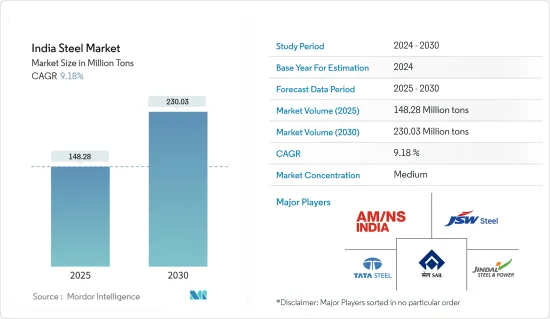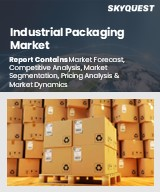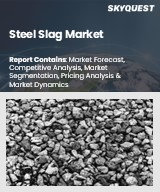
|
시장보고서
상품코드
1693723
인도의 철강 시장 : 점유율 분석, 산업 동향과 통계, 성장 예측(2025-2030년)India Steel - Market Share Analysis, Industry Trends & Statistics, Growth Forecasts (2025 - 2030) |
||||||
■ 보고서에 따라 최신 정보로 업데이트하여 보내드립니다. 배송일정은 문의해 주시기 바랍니다.
인도의 철강 시장 규모는 2025년 1억 4,828만 톤으로 추정되며, 예측 기간(2025-2030년) 동안 9.18%의 연평균 복합 성장률(CAGR)로 2030년에는 2억 3,003만 톤에 달할 것으로 예측됩니다.

주요 하이라이트
- 인도에서는 자동차 및 운송, 건축 및 건설, 기타 산업을 포함한 모든 산업의 철강 소비가 코로나19로 인해 제한되었습니다. 그러나 인도 철강 시장은 바이러스 확산을 억제하기 위해 최종 사용자 산업이 원활하게 기능하면서 강력한 회복세를 보였습니다. 현재 철강 시장은 팬데믹에서 회복되어 크게 확대되고 있습니다.
- 단기적으로는 인도 정부의 강력한 정책적 지원, 철강 부문에 대한 활발한 투자 유입, 도시화 진전, 건설 인프라 프로젝트에 대한 지출 증가가 예측 기간 동안 시장을 견인할 것으로 예측됩니다.
- 그러나 1인당 철강 소비량이 적고 생산비용이 높기 때문에 인도 철강업체들의 이윤율은 크게 하락했습니다. 가격 변동은 수입업체에 막대한 손실을 가져왔고, 인도 철강 시장의 성장을 저해했습니다.
- 철강 제조에서 탄소 대신 수소를 사용하고 향후 무역 및 투자 기회가 증가할 것으로 예상에 따라, 조사 대상 시장은 예측 기간 동안 유리한 성장을 이룰 가능성이 높습니다.
인도 철강 시장 동향
BF-BOF 기술이 시장을 장악합니다.
- BF-BOF 루트는 2단계 공정입니다. 제철 : 제철 : 철광석, 코크스, 석회석을 용광로에 투입합니다. 철광석을 제련하여 녹은 선철을 생산합니다. 다음으로 제강입니다. 용융 선철은 염기성산소로(BOF)에 투입됩니다. 석탄은 제철을 위한 주요 탄소 함유 물질로 사용됩니다. 철광석을 제련하여 액체 철로 바꾸는 데 필요한 고온을 발생시키고 있습니다. 이 액체 철은 전로(轉爐)에 들어가 녹은 철에 산소를 불어넣어 탄소와 기타 불순물을 제거합니다.
- 이렇게 만들어진 강철은 잉곳이나 슬래브로 주조되고, 여러 번의 압연 공정을 거쳐 봉강, 선재, 평강판 등 긴 길이의 제품으로 가공됩니다. 필요에 따라 강재의 특성과 기능을 향상시키기 위해 필요에 따라 템퍼링과 코팅이 이루어지기도 합니다.
- 고로는 하루에 최대 1만 톤의 쇳물을 생산할 수 있습니다. 고로는 한 번의 가열로에서 최대 300톤의 철강을 생산할 수 있습니다.
- 염기성 산소로(BOF)는 인도에서 조강 생산의 가장 선호되는 공정 경로였습니다. 2022년 말 기준, BOF 기술은 인도 철강 생산량의 90% 이상을 차지하했고, 생산량의 46%를 차지했습니다.
- 인도에서는 철강의 68%가 용광로 경로로 생산되며, 원료탄이 주요 환원제입니다. 동시에 미분탄 주입(PCI)과 천연가스를 보조 환원제로 사용할 수 있으며, BF-BOF 경로에서는 PCI를 대체할 수 있는 그린 수소가 개발되고 있습니다.
- 인도 철강부에 따르면, 2022년 말 기준 인도의 조강 생산은 BOF가 가장 선호되는 공정 경로로 약 5,743만 톤(전체 조강의 46%)을 생산하여 2021년 대비 8.35% 증가하였습니다.
- 예측 기간 동안 대부분의 BOF 공장은 인도에 설치될 것입니다. 예를 들어, Tata Steel BSL Ltd.는 2024년까지 오디샤 주 Meramandali 공장에서 607만 톤의 BOF 용량을, Kalinganagar 공장에서 300만 톤의 BOF 용량을 추가했습니다. 또한, 인도에는 5,000만 톤의 잠재적 총 생산능력이 더 있습니다.
- 따라서 인도에서 BF-BOF 기술의 성장 추세를 고려할 때, BF-BOF 기술이 시장을 독점할 가능성이 높습니다. 그 결과, 예측 기간 동안 철강 수요가 확대될 것으로 예측됩니다.
시장을 독점하는 건축 및 건설 산업
- 철강은 철계 금속으로 분류되는 인공 합금입니다. 철(지구상에 자연적으로 존재하는 금속 원소), 탄소, 기타 성분을 포함합니다. 건설은 높은 내구성과 강도로 인해 철강을 사용한 구조물이 만들어지기 때문에 철강이 널리 사용되는 분야입니다. 철골 구조물은 자연재해에도 견딜 수 있으며, 특정 프로젝트의 요구에 맞게 조정할 수 있습니다.
- 지붕재, 도리, 내벽, 천장, 피복재, 외벽용 단열패널 등의 제품은 철강으로 만들어집니다. 또한, 냉난방 설비나 실내 덕트 등 건축물의 비구조용도의 많은 부분에도 스틸이 사용되고 있습니다.
- 주택에서 주차장, 학교, 초고층 빌딩에 이르기까지 모든 건축물은 강도 측면에서 강철에 의존하고 있습니다. 또한 지붕과 외벽의 피복재에도 스틸이 사용됩니다. 난간, 선반, 계단 등의 내부 설비도 강철로 만들어집니다. 철골은 건물에 견고하고 단단한 골격을 설명합니다.
- 국가투자촉진촉진청에 따르면, 2022-23년 GDP에서 건축 및 건설 산업이 차지하는 비중은 약 9%였고, 약 5,100만 명이 이 산업에 종사하고 있었습ㄴ디ㅏ. 또한, 주택 및 비주거 부문 증가로 인해 2025년에는 1조 4,000억 달러에 달할 것으로 예측됩니다.
- 인도산업연맹(CII)에 따르면, 2022년 국내 주택 건설이 호조를 보였으며, 상위 7개 도시(델리 NCR, 방갈로르, 방갈로르, 하이데라바드, 뭄바이, 푸네, 첸나이, 콜카타)가 그 견인차 역할을 했습니다. 2021년 대비 44% 증가한 약 40만 2,000채의 신규 주택이 추가되었으며, 2023년 1분기(Q1) 상위 7개 도시의 주택 판매량은 11만 4,000채로 2022년 대비 9만 9,500채 이상 증가했습니다.
- 만인을 위한 주택을 촉진하는 프라단 만트리 아와스 요주나(Pradhan Mantri Awas Yojana), 사르다르 파텔(Saldar Patel) 도시 주택 프로젝트, 100대 스마트시티 미션, 중소도시 인프라 건설 등 정부의 사회 부문 프로그램이 인도 철강 산업의 성장을 가속하고 있습니다.
- 인도 정부는 경제 성장을 가속하기 위해 인프라 구축에 주력하고 있으며, 2022-23년 도로 및 교량 인프라 구축에 약 6,457억 3,000만 루피(77억 7,356만 달러)를 배정했습니다. 또한, 중앙 비스타 프로젝트에 따라 비주거용 오피스 빌딩을 건설하기 위해 260억 루피(3억 1,300만 달러)를 발행했습니다. 또한, 국가 인프라 파이프라인(NIP)에 따라 108조 루피(1조 3,000억 달러) 규모의 인프라 프로젝트가 다양한 실행 단계에 있습니다.
- 따라서 인도의 건축 및 건설의 성장 추세를 고려할 때, 건축 및 건설 산업이 시장을 독점할 가능성이 높습니다. 그 결과, 예측 기간 동안 철강 수요가 증가할 것으로 예측됩니다.
인도의 철강 산업 개요
인도의 철강 시장은 부분적으로 세분화되어 있습니다. 주요 기업으로는 JSW STEEL LIMITED, TATA STEEL, Steel Authority of India Limited(SAIL), AM/NS INDIA, JINDAL STEEL & POWER LIMITED 등이 있습니다.
기타 혜택
- 엑셀 형식 시장 예측(ME) 시트
- 3개월간 애널리스트 지원
목차
제1장 서론
- 조사의 전제조건
- 조사 범위
제2장 조사 방법
제3장 주요 요약
제4장 시장 역학
- 성장 촉진요인
- 성장 억제요인
- 산업 밸류체인 분석
- Porter의 Five Forces 분석
- 공급 기업의 교섭력
- 바이어의 교섭력
- 신규 진출업체의 위협
- 대체품의 위협
- 경쟁 정도
제5장 시장 세분화
- 기본 형태
- 조강(Crude Steel)
- 최종 형태
- 완성 철강
- 제조 기술
- BF-BOF
- 전기 아크로(EAF)
- 기타
- 최종사용자 산업
- 자동차 및 운송
- 건축 및 건설
- 공구 및 기계
- 에너지
- 소비재
- 기타 최종사용자 산업(석유 및 가스 추출 장비, 가구, 파이프, 팰릿, 드럼, 포장, 반도체)
제6장 경쟁 구도
- 합병, 인수, 합병사업, 제휴 및 협정
- 시장 점유율 분석
- 주요 기업의 전략
- 기업 개요
- AM/NS India
- Jindal Stainless LIMITED
- JINDAL STEEL & POWER LIMITED
- JSW STEEL LIMITED
- NMDC Steel Limited
- RASHTRIYA ISPAT NIGAM LIMITED
- Steel Authority of India Limited(SAIL)
- TATA STEEL
- Vedanta Limited
제7장 시장 기회와 향후 동향
LSH 25.05.20The India Steel Market size is estimated at 148.28 million tons in 2025, and is expected to reach 230.03 million tons by 2030, at a CAGR of 9.18% during the forecast period (2025-2030).

Key Highlights
- Steel consumption across industries in India, including automotive and transportation, building and construction, and others, was restricted owing to the COVID-19 pandemic. However, the Indian steel market witnessed a strong recovery with the smooth functioning of the end-user industries in curbing the spread of the virus. Currently, the steel market recovered from the pandemic and is expanding significantly.
- Over the short term, strong policy support by the Indian Government, the strong influx of investments in the steel sector, increasing urbanization, and increased spending on construction and infrastructure projects are projected to drive the market during the forecast period.
- However, due to low per capita steel consumption and high production costs, the profit margin significantly decreased for steel manufacturers in India. The price fluctuation caused huge losses to importers, which hampered the growth of the Indian steel market.
- Nevertheless, using hydrogen instead of carbon in steel manufacturing and increasing trade and investment opportunities in the future for the market studied are likely to create lucrative growth over the forecast period.
India Steel Market Trends
Blast Furnace-Basic Oxygen Furnace (BF-BOF) Technology to Dominate the Market
- The BF-BOF route is a two-stage process: Ironmaking: Iron ore, coke, and limestone are charged into a blast furnace. The iron ore is smelted to produce molten pig iron. Second, it is Steelmaking: Molten pig iron is charged into a basic oxygen furnace (BOF). Coal is used as the primary carbon-bearing material for steelmaking. It generates high temperatures necessary to smelt the iron ore and convert it into liquid iron. This liquid iron enters the converter, where oxygen is blown through the molten iron to remove carbon and other impurities.
- The resulting steel is cast into ingots or slabs and processed into long products like bars, wire, or flat steel strips in several rolling operations. To enhance the characteristics and functions of steel, tempering or coating applications are also done when required.
- Blast furnaces can produce up to 10,000 tons of molten pig iron daily. Then, BOFs can produce up to 300 tons of steel per heat.
- A basic oxygen furnace (BOF) was the most preferred process route for the production of crude steel in India. It accounts for over 90% of the country's steel output. At the end of 2022, BOF technology accounted for 46% of the production.
- In India, 68% of steel is made through the Blast Furnace route in which coking coal is the primary reductant. At the same time, Pulverised Coal Injection (PCI) or Natural Gas can be used as an auxiliary reductant. Green Hydrogen to replace PCI in the BF-BOF route is under development.
- According to the Ministry of Steel of India, BOF was the most preferred process route to produce crude steel in India at the end of 2022, with around 57.43 million tons (46% of total crude steel) produced, which was 8.35% higher than in 2021.
- Most BOF plant installations will occur in India in the forecast period. For instance, Tata Steel BSL Ltd. plans to add 6.07 MMT of BOF capacity at the Meramandali works and 3.0 MMT of BOF capacity at the Kalinganagar works in Odisha state by FY 2024. Moreover, India holds an additional 50.0 MMT potential gross capacity.
- Therefore, considering the growth trends of blast furnace-basic oxygen furnace (BF-BOF) technology in India, the BF-BOF technology is likely to dominate the market. It, in turn, is expected to enhance the demand for steel during the forecast period.
Building and Construction Industry to Dominate the Market
- Steel is a man-made alloy that falls within the ferrous metal classification. It contains iron (a naturally occurring metal element on earth), carbon, and other components. Construction is a sector where steel is widely used since structures are created using it due to its high durability and strength. Steel structures can also withstand natural calamities and be tailored to the needs of a specific project.
- Products, such as roofing, purlins, internal walls, ceilings, cladding, and insulating panels for exterior walls, are made of steel. Steel is also found in many non-structural applications in buildings, such as heating and cooling equipment and interior ducting.
- Buildings from houses to car parks, schools, and skyscrapers all rely on steel for strength. Steel is also used on roofs and as cladding for exterior walls. Internal fixtures and fittings, such as rails, shelving, and stairs, are also made of steel. It provides a robust and stiff frame to the building.
- According to the National Investment Promotion and Facilitation Agency, the building and construction industry accounted for nearly 9% of the GDP in FY 2022-23. Nearly 51 million people are employed in the industry. Moreover, The industry is expected to reach USD 1.4 trillion by 2025 owing to rising residential and non-residential sectors in the country.
- According to the Confederation of Indian Industry (CII), housing construction in the country witnessed strong demand in 2022, with the top seven cities (Delhi NCR, Bangalore, Hyderabad, Mumbai, Pune, Chennai, and Kolkata). It added around 402 thousand units of new home construction, which was 44% higher than in 2021. In the first quarter (Q1) of 2023, housing sales in the top seven cities stood at 1.14 lakh units, an increase of over 99,500 units compared to 2022.
- Government social sector programs such as the Pradhan Mantri Awas Yojna, which promotes housing for all, the Sardar Patel Urban Housing Project, the 100 Smart Cities Mission, and the construction of infrastructure in medium and small towns are promoting the growth of the Indian steel industry.
- The Government of India strongly focuses on infrastructure development to boost economic growth. In 2022-23, the government allocated around INR 64,573 crore (USD 7,773.56 Million) for developing new roads and bridge infrastructure. The ministry issued INR 2,600 crore (USD 313 Million) to construct non-residential office buildings under the Central Vista Project. Moreover, under the National Infrastructure Pipeline (NIP), infrastructure projects worth INR 108 trillion (USD 1.3 trillion) are at different stages of implementation.
- Therefore, considering the growth trends of building and construction in India, the building and construction industry is likely to dominate the market. It, in turn, is expected to enhance the demand for steel during the forecast period.
India Steel Industry Overview
The Indian steel market is partially fragmented in nature. The major players (not in any particular order) include JSW STEEL LIMITED, TATA STEEL, Steel Authority of India Limited (SAIL), AM/NS INDIA, and JINDAL STEEL & POWER LIMITED, among others.
Additional Benefits:
- The market estimate (ME) sheet in Excel format
- 3 months of analyst support
TABLE OF CONTENTS
1 INTRODUCTION
- 1.1 Study Assumptions
- 1.2 Scope of the Study
2 RESEARCH METHODOLOGY
3 EXECUTIVE SUMMARY
4 MARKET DYNAMICS
- 4.1 Drivers
- 4.1.1 Strong Policy Support by the Indian Government
- 4.1.2 Strong Influx of Investments in the Steel Sector
- 4.1.3 Increasing Urbanization and Increased Spending on Construction and Infrastructure Projects
- 4.2 Restraints
- 4.2.1 Low Percapita Steel Consumption
- 4.2.2 High Production Costs
- 4.3 Industry Value-Chain Analysis
- 4.4 Porter's Five Forces Analysis
- 4.4.1 Bargaining Power of Suppliers
- 4.4.2 Bargaining Power of Buyers
- 4.4.3 Threat of New Entrants
- 4.4.4 Threat of Substitute Products and Services
- 4.4.5 Degree of Competition
5 MARKET SEGMENTATION (Market Size in Volume)
- 5.1 Basic Form
- 5.1.1 Crude Steel
- 5.2 Final Form
- 5.2.1 Finished Steel
- 5.3 Technology
- 5.3.1 Blast Furnace-basic Oxygen Furnace (BF-BOF)
- 5.3.2 Electric Arc Furnace (EAF)
- 5.3.3 Other Technologies
- 5.4 End User Industry
- 5.4.1 Automotive and Transportation
- 5.4.2 Building and Construction
- 5.4.3 Tools and Machinery
- 5.4.4 Energy
- 5.4.5 Consumer Goods
- 5.4.6 Other End-user Industries (Oil and Gas Extraction Equipment, Furniture, Pipes, Barrels, Drums, Packaging, Semiconductors)
6 COMPETITIVE LANDSCAPE
- 6.1 Mergers, Acquisitions, Joint Ventures, Collaborations, and Agreements
- 6.2 Market Share Analysis
- 6.3 Strategies Adopted by Leading Players
- 6.4 Company Profiles
- 6.4.1 AM/NS India
- 6.4.2 Jindal Stainless LIMITED
- 6.4.3 JINDAL STEEL & POWER LIMITED
- 6.4.4 JSW STEEL LIMITED
- 6.4.5 NMDC Steel Limited
- 6.4.6 RASHTRIYA ISPAT NIGAM LIMITED
- 6.4.7 Steel Authority of India Limited (SAIL)
- 6.4.8 TATA STEEL
- 6.4.9 Vedanta Limited
7 MARKET OPPORTUNITIES AND FUTURE TRENDS
- 7.1 Growing Trend of Circular Economy
샘플 요청 목록



















